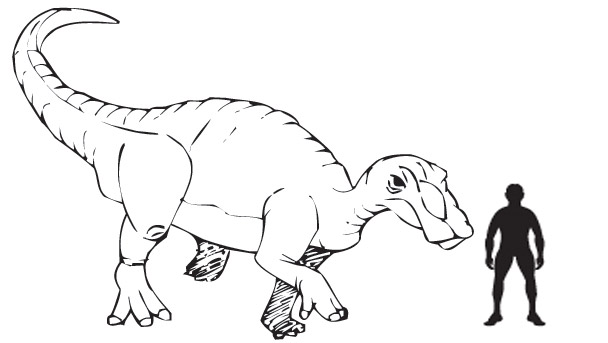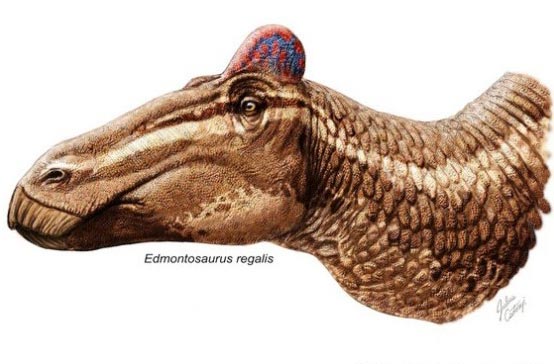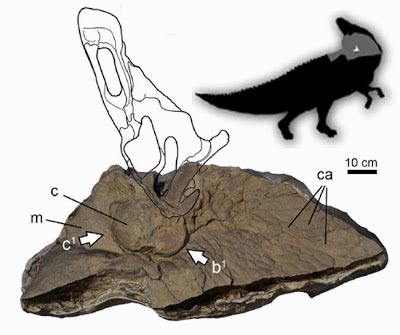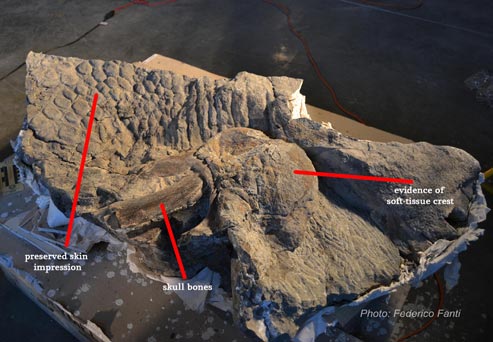Mummified Edmontosaurus Fossil Provides Evidence of a Soft-Tissue Comb like a Rooster
The weird and wonderful world of the Dinosauria just got a little more peculiar with the publication of a scientific paper in the academic journal “Current Biology” that announces the discovery of a soft-tissue comb present in the fossilised remains of a duck-billed dinosaur discovered in Canada. The fossil record rarely preserves soft tissues and although a number of palaeontologists had suspected that some types of dinosaur may have sported flamboyant soft tissue crests, fossil evidence had been rather thin on the ground.
Soft Tissue Crest
Looking at birds, reptiles and mammals today a number of species have various soft skin pouches, wattles combs and even trunks in the case of members of the Proboscidea. So why not extinct animals? It seems that scientists examining the skull of a beautifully mummified hadrosaur from Upper Cretaceous sediments that make up the Wapiti Formation (Alberta, Canada) have uncovered evidence of soft tissue crests in a species of Edmontosaurus (E. regalis) whilst working close to the city of Grande Prairie.
The three-dimensional, cranial crest seems to be entirely composed of soft tissue. Its location came as a big surprise to Dr Phil Bell (Department of Environmental and Rural Science, University of New England, Armidale, New South Wales, Australia), as he put his chisel through the middle of it as he prepared the fossil skull specimen. He simply did not expect to find any structure that was part of the dinosaur in that part of the matrix that he was excavating.
Duck-billed Dinosaur
Edmontosaurus is one of the best known Late Cretaceous dinosaurs. It was one of the most abundant types of dinosaur roaming North America in the Late Cretaceous. These herbivores grew up to 12 metres in length and a number of species have been described from fossil remains found in both the United States and Canada.
An Illustration of an Edmontosaurus
Picture credit: Everything Dinosaur
Commenting on the discovery, Dr Bell stated:
“An elephant’s trunk or a rooster’s comb might never fossilise because there is no bone in them. This discovery is equivalent to learning for the first time that elephants had trunks. We have lots of skulls of Edmontosaurus, but until now there have been no clues to suggest they might have had a big fleshy crest.”
“Flat-headed Hadrosaurines”
Previously, palaeontologists had described the likes of Edmontosaurus as “flat-headed hadrosaurines”, their skulls generally lacking the spectacular bony, hollow crests of the lambeosaurine hadrosaurs, dinosaurs such as Corythosaurus and Lambeosaurus. Now it looks like this view is going to have to be revised. The crests on some hadrosaurs had been linked to vocalisation, social signalling or intra-specific competition where animals of the same species might compete for mates.
This fossil find, from a mummified Edmontosaurus, one of a few dinosaur “mummies” known to science, provides the first view of a soft-tissue signalling structure in the Dinosauria.
A spokesperson from Everything Dinosaur commented:
“Although no colour evidence has been recovered from the fossil, we can speculate that this was a colourful crest, further evidence of ornamentation in the Dinosauria. This is additional evidence that hints at complicated social behaviour amongst ornithopods.”
Crest evolution within Hadrosaurinae apparently culminated in the secondary loss of the bony crest in genera that lived at the very end of the age of dinosaurs. However, the new specimen indicates that cranial ornamentation was in fact not lost but substituted in Edmontosaurus by a fleshy display structure. It also implies that visual display played a key role in the evolution of hadrosaurine crests and raises the possibility of similar soft-tissue structures among other members of the Dinosauria.
An Illustration of E. regalis with the “Rooster” Comb
Picture credit: Julius Csotonyi
A Mummified Dinosaur
Described as being like a rather small, rounded bowler hat-like structure, the palaeontologists studying the fossil material estimate the soft-tissue crest was approximately 20 centimetres high and perhaps as much as 30 centimetres in length. Although the fossilised remains are described as “mummified” this is not a technically correct term. Very hot and dry conditions can desiccate the bodies of once living creatures, leading to a remarkable degree of preservation.
In the case of the dinosaur fossils often referred to as “mummies”, their remains have been buried quickly, the bones are in the “life position” and articulated, very occasionally soft tissue structures such as skin impressions are preserved. However, this is the first time that scientists have found evidence of a skull crest comprised entirely of soft tissue.
Dr Bell went onto to speculate that other dinosaurs, even really famous ones might have sported soft-tissue crests and other structures. He stated:
“There’s no reason that other strange fleshy structures couldn’t have been present on a whole range of other dinosaurs, including T. rex or Triceratops.”
The hadrosaur specimen has been preserved in the typical “death pose” of a dinosaur, with the head and neck arched over the back, the picture below shows the position of the fossil portion in respect to the rest of the animal and the white arrows indicate the position of the crest.
Looking at the Crest Fossil Material (E. regalis)
Picture credit: Federico Fanti et al/Current Biology
The white arrows indicate the position of the crest, “c” = comb or crest indicate, the “m” refers to matrix, infill by sediment. Scale bar shown represents 10 centimetres and the “ca” represents cluster areas which are referred to within the scientific paper.
A Close up of the Edmontosaurus Skull Material
Picture credit: Federico Fanti
This fossil discovery provides further evidence that the bones of dinosaur and other vertebrates do not necessarily, give us the complete picture of how they actually looked. The research team have to be congratulated for the great care they have taken (not withstanding the odd slip with the chisel), in the preparation of this fossil material.









Leave A Comment